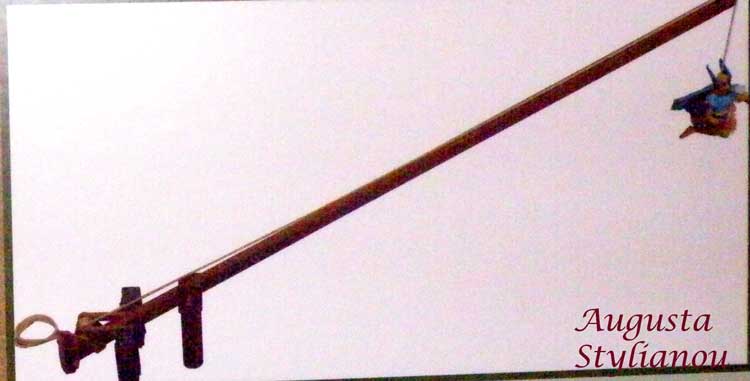
God "from the machine" (Deux ex machina). Photo : Augusta Stylianou Artist
Lifting machine of the ancient theatre (since Aeschylus), used for the impressive hovering and descending of determinant persons on the stage for the action of the play (e.g. heroes, gods, etc.) and rarely heavier loads (such as tanks or horses with riders, platforms with the chorus, etc.). According to the merging of literary and pottery information, this consisted of a long jointed beam which was based on a rotating vertical beam. The load was ascended by rope ("hammock") through a pulley and manual winch located on both ends of the beam. The beam had a counterweight to balance the risen load. The machine was mounted behind the scene near the left passage in a nearly horizontal position. The operator of the machine, after balancing the load (with counterweight), gave (through levers) the requires slope and then the required rotation to the beam so the the load be found above the middle of the proscenium.
One wheel at the end of the balanced beam may have facilitated the operator in the rotation. When the action requested, he executed waving effects to the weighted load. Finally, lifting the load onto the proscenium with the help of the winch.

God "from the machine" (Deux ex machina). Photo : Augusta Stylianou Artist
From "Ancient Greek Technology" exhibition at the Evagoras & Kathleen Lanitis Centre in Carob Mill Limassol
Replicas and Reconstruction by Prof . Kostas Kotsanas and his students
| Ancient Greece
Science, Technology , Medicine , Warfare, , Biographies , Life , Cities/Places/Maps , Arts , Literature , Philosophy ,Olympics, Mythology , History , Images Medieval Greece / Byzantine Empire Science, Technology, Arts, , Warfare , Literature, Biographies, Icons, History Modern Greece Cities, Islands, Regions, Fauna/Flora ,Biographies , History , Warfare, Science/Technology, Literature, Music , Arts , Film/Actors , Sport , Fashion --- |

